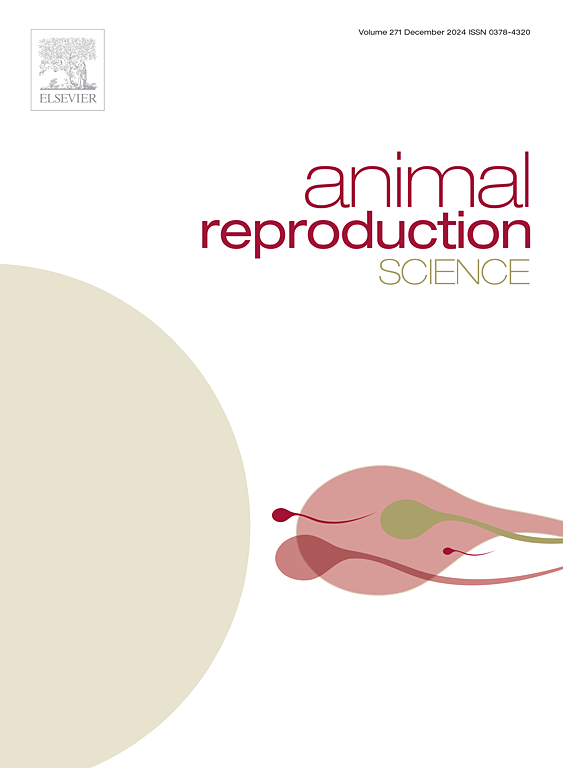The effects of mitochondria-targeted (MitoQ and Mito-TEMPO) and untargeted (SOD and CoQ10) antioxidants on ram’s sperm quality and fertility potential during the cryopreservation process
IF 3.3
2区 农林科学
Q1 AGRICULTURE, DAIRY & ANIMAL SCIENCE
引用次数: 0
Abstract
Sperm cryopreservation is a widely used procedure for storing donor semen prior to artificial insemination. However, spermatozoa experience biochemical and functional changes during cryopreservation. The current study aimed to compare the effects of mitochondrial-targeted (MitoQ and Mito-TEMPO) and untargeted (SOD and CoQ10) antioxidants on the quality traits of ram sperm and reproductive performance. Semen samples were collected and diluted in extenders as follows: the first group served as the control, while the other groups were supplemented with 100 U/mL superoxide dismutase (SOD), 1 μM CoQ10 (Q10), 50 and 100 nM MitoQ (MQ50 and MQ100), 50 and 100 μM Mito-TEMPO (MT50 and MT100), and 50 nM MitoQ+ 50 μM Mito-TEMPO (MQ/MT). After the freezing, sperm quality characteristics and fertility potential were evaluated. According to the current results, the groups MQ50, MQ100, MT50, MT100, and MQ/MT exhibited higher (P ≤ 0.05) rates of total motility (TM), progressive motility (PM), average path velocity (VAP), membrane integrity (MI), mitochondrial activity potential (MAP), acrosome integrity (AI), viable cells, and fertility potential, as well as lower (P ≤ 0.05) late apoptotic-like changes, DNA fragmentation, H2O2 concentration, and malondialdehyde (MDA) concentrations compared to the SOD and Q10 groups. Moreover, superoxide dismutase (SOD) concentration increased (P ≤ 0.05) in the groups of SOD, MT50, MT100, and MQ/MT than in other groups. Furthermore, the MQ/MT group exhibited the highest (P ≤ 0.05) rates of TM, PM, VAP, MI, MAP, AI, viable cells, and fertility potential, along with the lowest (P ≤ 0.05) late apoptotic-like changes, DNA fragmentation, H2O2 concentration, and MDA concentrations relative to the other groups. In conclusion, incorporating MitoQ+Mito-TEMPO into the extender during the semen freezing could be a valuable strategy to enhance the success of ram frozen semen.
线粒体靶向抗氧化剂(MitoQ和Mito-TEMPO)和非靶向抗氧化剂(SOD和CoQ10)对低温保存过程中公羊精子质量和生育潜力的影响
精子冷冻保存是一种广泛使用的程序,用于在人工授精之前储存供体精液。然而,精子在冷冻保存过程中经历了生化和功能的变化。本研究旨在比较线粒体靶向抗氧化剂(MitoQ和Mito-TEMPO)和非靶向抗氧化剂(SOD和CoQ10)对公羊精子质量性状和生殖性能的影响。采集精液样本,用增液稀释:第一组为对照,其余各组分别添加100 U/mL超氧化物歧化酶(SOD)、1 μM CoQ10 (Q10)、50和100 nM MitoQ (MQ50和MQ100)、50和100 μM Mito-TEMPO (MT50和MT100)、50 nM MitoQ+ 50 μM Mito-TEMPO (MQ/MT)。冷冻后,评估精子质量特征和生育潜力。根据目前的结果,与SOD和Q10组相比,MQ50、MQ100、MT50、MT100和MQ/MT组在总运动性(TM)、进行性运动性(PM)、平均路径速度(VAP)、膜完整性(MI)、线粒体活性电位(MAP)、顶体完整性(AI)、活细胞和生育潜力方面表现出更高的(P ≤ 0.05)率,以及更低的(P ≤ 0.05)晚期凋亡样改变、DNA片段化、H2O2浓度和丙二醛(MDA)浓度。SOD、MT50、MT100和MQ/MT组超氧化物歧化酶(SOD)浓度显著高于其他各组(P ≤ 0.05)。此外,与其他各组相比,MQ/MT组的TM、PM、VAP、MI、MAP、AI、活细胞率最高(P ≤ 0.05),生育潜能最高(P ≤ 0.05),晚期凋亡样改变、DNA片段化、H2O2浓度和MDA浓度最低(P ≤ 0.05)。综上所述,在精液冷冻过程中加入MitoQ+Mito-TEMPO可以提高公羊冷冻精液的成功率。
本文章由计算机程序翻译,如有差异,请以英文原文为准。
求助全文
约1分钟内获得全文
求助全文
来源期刊

Animal Reproduction Science
农林科学-奶制品与动物科学
CiteScore
4.50
自引率
9.10%
发文量
136
审稿时长
54 days
期刊介绍:
Animal Reproduction Science publishes results from studies relating to reproduction and fertility in animals. This includes both fundamental research and applied studies, including management practices that increase our understanding of the biology and manipulation of reproduction. Manuscripts should go into depth in the mechanisms involved in the research reported, rather than a give a mere description of findings. The focus is on animals that are useful to humans including food- and fibre-producing; companion/recreational; captive; and endangered species including zoo animals, but excluding laboratory animals unless the results of the study provide new information that impacts the basic understanding of the biology or manipulation of reproduction.
The journal''s scope includes the study of reproductive physiology and endocrinology, reproductive cycles, natural and artificial control of reproduction, preservation and use of gametes and embryos, pregnancy and parturition, infertility and sterility, diagnostic and therapeutic techniques.
The Editorial Board of Animal Reproduction Science has decided not to publish papers in which there is an exclusive examination of the in vitro development of oocytes and embryos; however, there will be consideration of papers that include in vitro studies where the source of the oocytes and/or development of the embryos beyond the blastocyst stage is part of the experimental design.
 求助内容:
求助内容: 应助结果提醒方式:
应助结果提醒方式:


